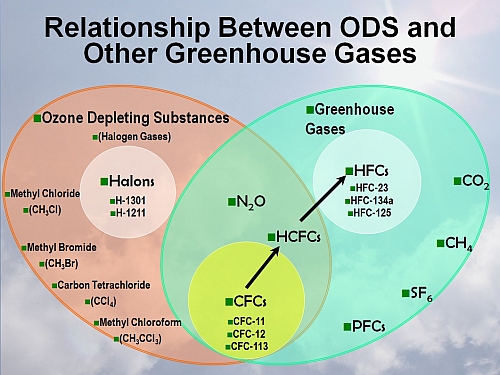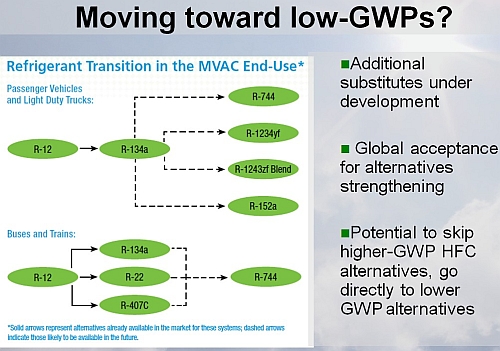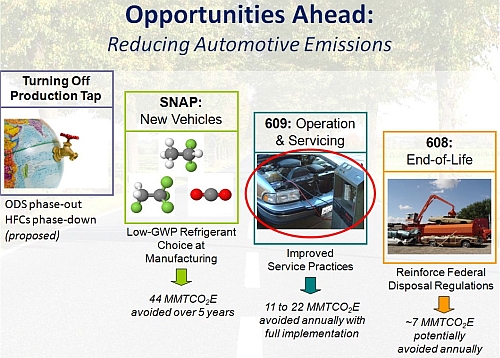Phaseout of ozone depleting substances (ODS) heals the air we breatheIn the past 20 years, ozone protection has been a key focus. Collaborative industry-research-government efforts — such as the Montreal Protocol — have slowed and reversed the accumulation of ozone depleting substances. Hufford praised the industry’s willingness to embrace environmentally friendly refrigerants that helped to reduce ozone depletion.Also, in the last 20 years, the industry has seen a refrigerant shift from chlorofluorocarbons (CFCs) to hydrochlorofluorocarbons (HCFCs), such as R-12, and then to hydrofluorocarbons (HFCs), such as R-134a. Hufford praised this steady transition from refrigerants with high global warming propensity to less harmful alternatives. “Between 2050 and 2075, we’re going to see a return of the ozone layer to the type of thickness it had before human interference began with the introduction of CFCs,” Hufford noted. “The ozone layer is being healed, and we can expect skin cancer and other related illnesses to be reduced significantly in the years ahead. |
 The U.S. Environmental Protection Agency (EPA) emphasis during the past 20 years on the reduction of ozone depleting substances (ODS) has been effective. (All Images — EPA) |
 Reducing greenhouse gas emissions over the next 20 year is the EPA primary mobile air conditioning focus. This will be implemented via a phasedown from high global warming potential (GWP) to low-GWP refrigerants such as HF0-1234yf for light duty vehicles; R-744 for buses, heavy duty vehicles and trains; and others currently under development. |
Shift to low gobal warming potential refrigerants heals the EarthHufford said further environmental progress in the U.S. needs the continued cooperation from the MVAC industry. “We think the MVAC industry is going to have a big influence on environmental protection, particularly in the next few years.”Global acceptance of lower global warming potential (GWP) refrigerant alternatives is strengthening, Hufford explained, so the potential to skip higher-GWP HFC alternatives and go to directly to low-GWP alternatives will have a huge environmental impact. The next significant move will be a phasedown — but not a complete phaseout — of higher-GWP HFC-based refrigerants (e.g. R-134a). New products at manufacture will transition to emerging significantly lower-GWP refrigerants, such as HFO-1234yf (e.g. light duty vehicles), HFO-1234ze (e.g. as a foam-blown insulating agent refrigerated trailers), and R-744 (e.g. buses, heavy duty vehicles and trains). |
| Government regulators are
also
working towards harmonizing their standards and expectations. On Jan.
24, 2011, for example, the state of California, U.S. Department of
Transportation (DOT) and EPA announced a common timeframe for proposing
fuel economy and greenhouse gas standards for model year 2017-2025 cars
and light-duty trucks. Key tenets include the use of a low-GWP
refrigerant, improving performance efficiencies, limiting leak rates
and limiting indirect emissions (e.g. through the use new
emissions-saving technology not yet developed). This effort to harmonize signals continued collaboration that could lead to an extension of the current National Clean Car Program. It also provides automakers with regulatory certainty as they work to build the next generation of clean, fuel-efficient cars and cut emissions of harmful pollutants.
Nuts and bolts: Making a refrigerant changeFrom an environmental perspective, HFO-based refrigerants are greener and safer than earlier generations of refrigerants. The proposed final rule for HFO-1234yf was published on Oct. 27, 2010, which was followed by a mandatory public comment period that ended Feb. 1, 2011. Hufford notes that EPA is considering a petition to exempt HFO-1234yf and HFO-1234ze as being volatile organic compounds (VOCs), which are can lead to the creation of irritating ground-level ozone.If granted, rule making would have to reflect this and state regulators would not have to regulate these compounds. The exemption may open the sale of these products to ‘do-it-yourself’ consumers, which has environmentalists concerned. Hufford added that the EPA will then send the final rule to the White House Office of Management for review, with the expectation that the final rule will be ready for publication by Spring 2011. For the CO2-based R-744 refrigerant, EPA says the same process will be followed, and it anticipates a final rule by this summer or fall. As written, the HFO-1234yf rule requires automakers will be required to notify the EPA 90 days before using HFO-1234yf in activities designated as significant new use, such as in a new vehicle. For instance, General Motors has already announced its intention to introduce HFO-1234yf in MY2013 vehicles; some German automakers also plan an introduction, possibly before then; and Aston Martin has said it will be ready no later than MY2017. For the aftermarket, opportunity knocksChemical manufacturers have indicated they have the ability to supply enough HFO-1234yf, provided they receive firm purchase commitments and sufficient lead-time from customers. EPA also requires that the new refrigerant have unique fittings and labels, distinguishing it from other refrigerants.Costs have yet to be announced, but a source who asked to remain anonymous indicated the new refrigerant would likely sell for more than $100 per pound. The source also said that HFO-1234yf would be shipped in white tanks that had a red stripe around the tank shoulder. |
|||||||||||||||||||||||||||||||||||
 Besides the proposed phasedown of high-GWP, HFC-based refrigerants such as R-134a), the EPA says that other future steps to reduce greenhouse gas emissions include automakers deciding to adopt low-GWP refrigerants, the updating and implementation of Section 609 technician certification and the enforcement of Section 608 federal end-of-life disposal regulations |
The EPA also provides
incentives to help the MVAC industry move towards increasingly robust
performance and efficiency of mobile A/C systems. Auto manufacturers,
for example, can earn credits by improving A/C that can be applied
toward their fleet-wide average CO2 emissions standards. These credits
include HVAC efficiency credits (measured by an A/C idling test),
leakage credits (measured system losses) and off-cycle credits, which
relate to the capture of emissions enabled by new and innovative
technologies not yet on vehicles. The rule’s Section 609 Certification requires EPA-approved training. This training encompasses technician education for EPA-approved MVAC refrigerants, sales restrictions, required recordkeeping and the potential adoption and use of SAE J2852 recovery-only and J2844 recovery/recycle/recharging equipment. Hufford shared that EPA expects to have an update for Section 609 Certification by Spring 2012. |
| The automotive aftermarket also
has several A/C service opportunities, Hufford added. For example,
equipment suppliers and tool makers who act early will be first to
market with HFO-1234yf capable shop equipment, tools, fittings hoses,
and other necessities. In addition, by preparing and specializing in
best A/C service practices now, notably through Section 609
certification, A/C service businesses can recognize and capitalize on
opportunities that include system leak reduction, proper repair of A/C
systems rather than providing system top-offs and employing better
recovery/recycling/replacement practices. “The MVAC’s willingness to embrace emerging refrigerants that have much lower global warming potential is crucial,” Hufford concluded. “We still need your help.” |
|
 |
|

 Contributed by Bob Chabot
Contributed by Bob Chabot